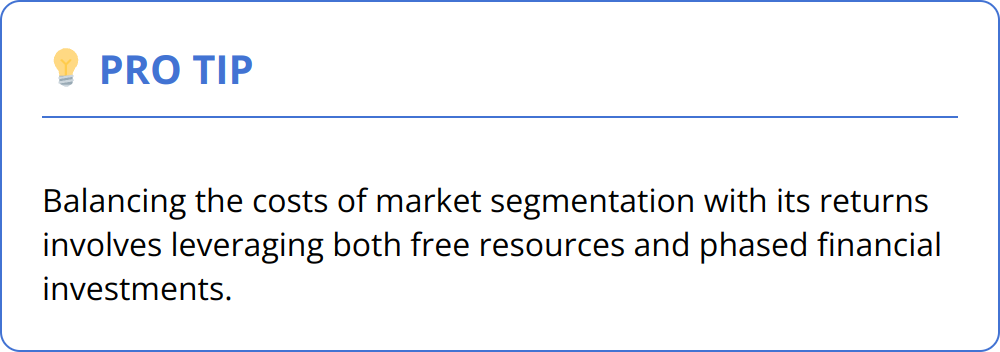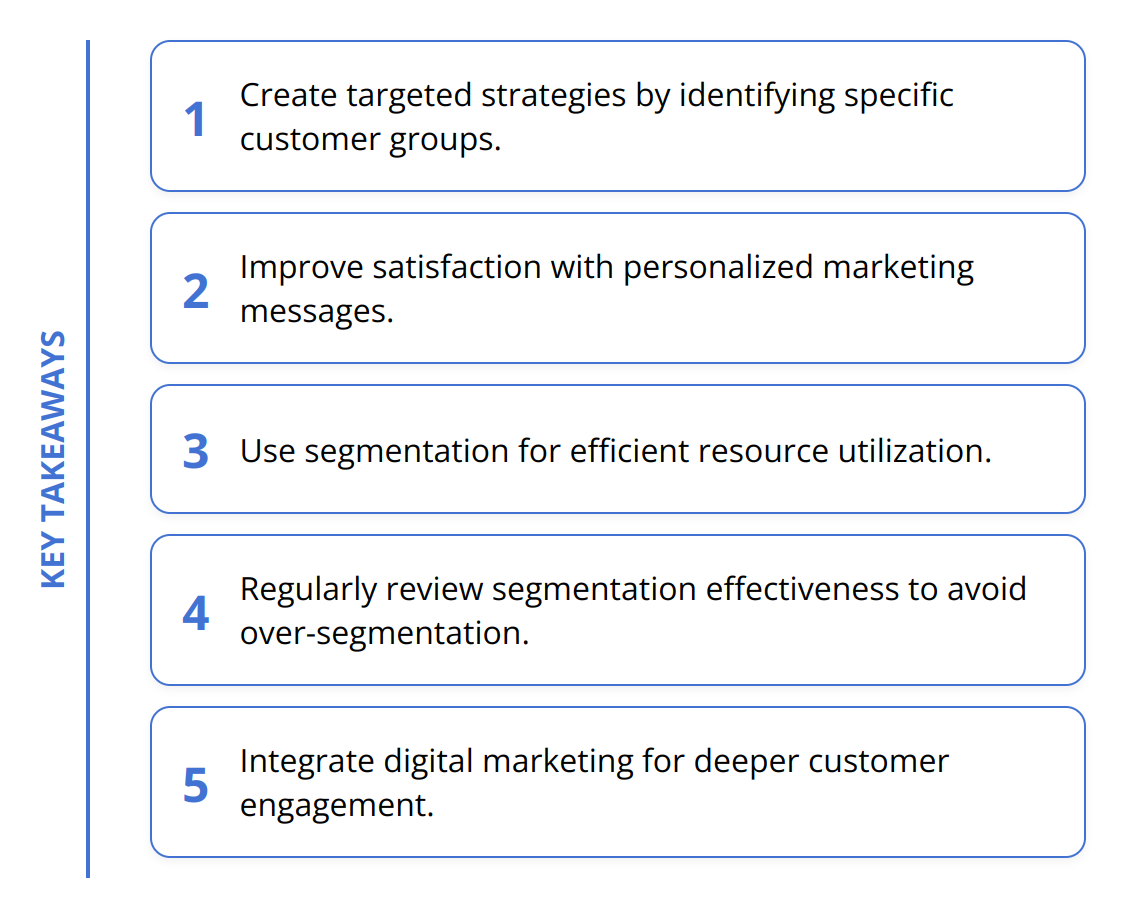We at Emplibot believe understanding market segmentation is fundamental for crafting strategies that truly connect with different customer groups. Targeting the right audience not only streamlines resource allocation but also elevates customer satisfaction. However, navigating the complexities of segmentation demands a keen awareness of its potential drawbacks. Herein lies the challenge – balancing the advantages against the limitations for a holistic marketing approach.
Contents
ToggleAdvantages of Market Segmentation
Understanding and implementing market segmentation effectively can transform your marketing strategy, leading to significant benefits. Here’s why segmenting your market is a strategy too fruitful to overlook.
Hitting the Bullseye with Marketing Efforts
One of the most significant benefits of market segmentation is the ability to create targeted marketing strategies. By identifying specific groups within a broader market, companies can tailor their messaging to resonate deeply with each segment. This personalized approach is not just about making customers feel special; it’s a strategic move to increase the relevance of your products or services to their unique needs and preferences.
Consider how a beauty brand segments its market by age groups, creating specific skincare lines for teenagers, adults, and the elderly. This tailored strategy acknowledges that each group has distinct skincare concerns, leading to more effective marketing and higher sales figures.
Boosting Customer Satisfaction and Engagement
A direct consequence of targeted marketing is improved customer satisfaction and engagement. When customers feel that a brand understands their specific needs, they’re more likely to engage with the brand on various platforms, from social media to email. High engagement rates are a treasure trove of opportunities for businesses, opening doors to higher conversion rates, repeat purchases, and invaluable word-of-mouth marketing.

Maximizing Resource Efficiency
Last but definitely not least, market segmentation leads to the efficient use of resources. Marketing budgets stretch further when companies focus their efforts on the segments most likely to convert. By avoiding a one-size-fits-all approach, businesses save on resources that would otherwise be wasted on broad, less effective campaigns.
Consider the difference in ROI when a tech company targets its latest gaming laptop campaign specifically at gaming enthusiasts compared to a general tech audience. The targeted approach not only yields a higher conversion rate but also ensures that the marketing budget is spent on reaching the people most likely to purchase.

To wrap it up, segmentation enables marketers to craft precise marketing strategies, deeply understand their customers, and allocate resources in a way that maximizes both satisfaction and ROI. These advantages make market segmentation an indispensable tool in the marketer’s toolkit. For those looking to dive deeper into crafting effective segmentation strategies, exploring topics such as predictive customer segmentation can provide valuable insights and actionable strategies to further refine your marketing approach.
Market Segmentation Challenges
While market segmentation is a powerful tool, it’s not without its challenges. Moving beyond the benefits, it’s important to address the limitations that might hinder a successful segmentation strategy. These challenges need not discourage businesses but should be seen as opportunities for refinement and strategic thinking.
High Costs and Resource Demands
Segmenting a market requires comprehensive research and data analysis, which can be costly and time-intensive. For small businesses or startups, the initial investment in market research tools and expertise might be daunting. It’s critical to balance the potential gains with the upfront costs. Utilize free and low-cost resources when possible and consider phased investments in market research to mitigate financial risks.
The Pitfall of Over-Segmentation
While tailoring products and messages to specific groups can enhance engagement, there’s a thin line between effective segmentation and over-segmentation. The latter can lead businesses to create too many small segments, making marketing efforts fragmented and less impactful. This dilutes the brand’s message and can incur higher costs with diminishing returns. Striking the right balance requires regular review of segmentation effectiveness, ensuring that each segment is large enough to warrant individual attention but distinct enough to need it.
Misinterpreting the Market
Misinterpretation of market data can lead businesses astray, leading to strategies that miss the mark. This is often due to an overreliance on quantitative data without qualitative insights or not updating market research to reflect changing consumer behaviors. Regular interaction with your target audience, such as through focus groups or customer feedback, can provide the qualitative insights necessary to validate quantitative data. Additionally, staying informed about industry trends can help anticipate shifts in consumer behavior.

To navigate these challenges, consider the following tips:
-
Start with a clear objective for your segmentation.
-
Use a mix of qualitative and quantitative research methods.
-
Regularly review and adjust your segmentation strategy based on performance metrics and market changes.
-
Keep segments manageable in size and distinctiveness.
-
Balance the costs of segmentation with expected ROI.
Understanding these limitations is crucial for refining your segmentation strategy. By proactively addressing these challenges, businesses can maximize the effectiveness of their market segmentation efforts, ensuring they are not only reaching the right audience but doing so in an efficient and impactful way. For a closer look at balancing segmentation efforts, predictive analytics in marketing can offer insights into optimizing your strategy for the best outcomes.
Enhancing Segmentation with Digital Tactics
Enhancing your market segmentation strategy involves more than just identifying different customer groups. To truly excel, integrating segmentation with other marketing strategies is key. Below are methods to amplify your efforts, making your marketing more effective and efficient.
Digital Marketing Integration
Digital marketing platforms offer a treasure trove of tools for targeting and personalizing your content for different segments. For instance, social media enables you to tailor messages directly to the interests and behaviors of each segment. Email marketing, on the other hand, can be used to send personalized offers and content directly to the inbox of your segmented groups, significantly increasing open rates and conversions. In fact, segmented email campaigns experience as much as a 760% increase in revenue compared to non-segmented campaigns. Combining segmentation with digital marketing isn’t just beneficial; it’s a must for maximizing impact. Explore more on optimizing content strategy.
Leverage Data Analytics
In the age of information, data is king. Data analytics can supercharge your segmentation by providing deeper insights into customer behavior, preferences, and trends. By analyzing customer data, you can identify patterns and trends that weren’t apparent before. This could lead to the creation of new segments or the refinement of existing ones, making your marketing efforts even more targeted and effective. For example, predictive analytics can anticipate future buying behavior, enabling you to tailor your marketing strategies accordingly. Making data analytics a cornerstone of your segmentation strategy transforms raw data into actionable insights. Explore more on how data analytics enhances marketing.
Psychographic Meets Demographic
While demographic segmentation provides a solid foundation, integrating psychographic information takes your strategy to another level. This approach considers the lifestyle, values, attitudes, and interests of your segments, offering a richer, more holistic view of your customers. For a sports apparel brand, knowing that a segment includes 25-34-year-old women is useful. But understanding this group’s commitment to sustainability and wellness can lead to highly resonant marketing strategies. This dual approach enables you to craft messages that hit home on multiple levels, significantly boosting engagement and loyalty.
Tips for Implementing Integrated Strategies:
-
Regularly analyze your digital marketing data to adjust your segments.
-
Utilize customer feedback and engagement metrics to refine your messaging.
-
Experiment with combining different segmentation variables for unique insights.
-
Keep an eye on digital marketing trends to adopt new tools and platforms swiftly.

In conclusion, integrating your segmentation strategy with digital marketing, data analytics, and a mix of segmentation variables uncovers new opportunities for engagement and conversion. By adopting a combined approach, you’re not just reaching your audience; you’re deeply connecting with them, paving the way for long-term loyalty and success.
Final Thoughts
Through this exploration of market segmentation, it’s clear that understanding your audience and tailoring your marketing efforts accordingly can have a profound impact on your business’s success. The precision and efficiency gained through targeted strategies boost both customer satisfaction and the bottom line. Whether it’s through personalized email campaigns that significantly increase revenue or through the strategic deployment of digital marketing tools, segmentation is undoubtedly a powerful approach to marketing.

However, it’s also evident that market segmentation comes with its challenges. High costs, the risk of over-segmentation, and the potential for misinterpreting market data are real concerns that businesses must navigate carefully. The key to leveraging the full power of market segmentation lies in striking a balance between these advantages and limitations.
Successful segmentation is not just about creating categories; it’s about insightful understanding and strategic implementation. It demands a continuous cycle of research, analysis, and adjustment to keep pace with the evolving market and customer needs. Businesses that approach segmentation with a dynamic and thoughtful strategy will find themselves better positioned to connect with their audience on a deeper level.
At Emplibot, we believe that every business has the potential to achieve this level of connection with their audience. That’s why we’ve developed a platform that supports businesses in their content marketing efforts, helping them reach their targeted audience with SEO-friendly articles. With Emplibot, achieving a powerful online presence becomes effortless, allowing businesses to focus on refining their market segmentation strategies and engaging their audience like never before. Discover how Emplibot can transform your content marketing at Emplibot.
In conclusion, the journey toward effective market segmentation is both challenging and rewarding. By balancing the inherent advantages and limitations, and implementing a strategy that’s as dynamic as the markets we operate in, businesses can achieve unparalleled engagement and loyalty from their audience. Let market segmentation be your compass in the complex landscape of modern marketing, guiding you toward more meaningful connections and sustainable success.










 Rated Excellent 4.5
Rated Excellent 4.5